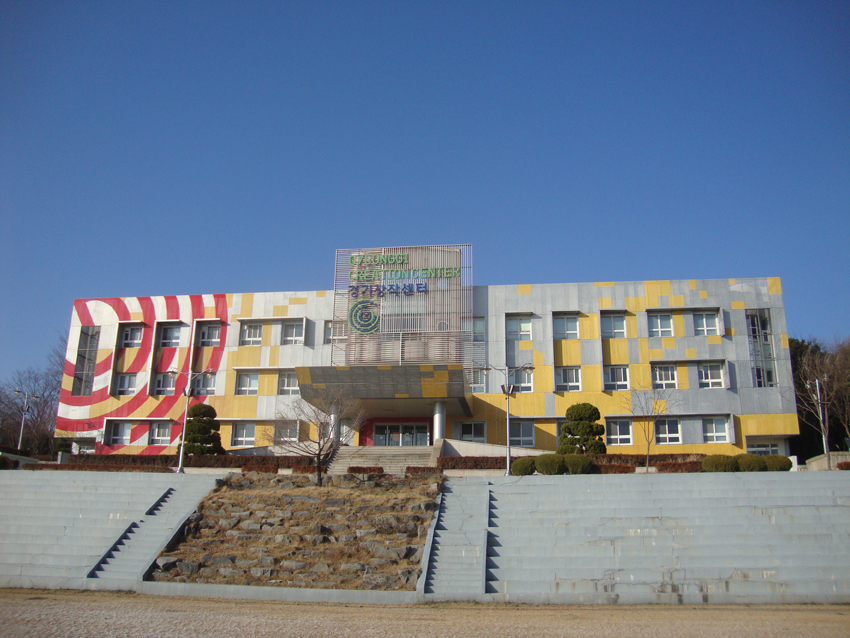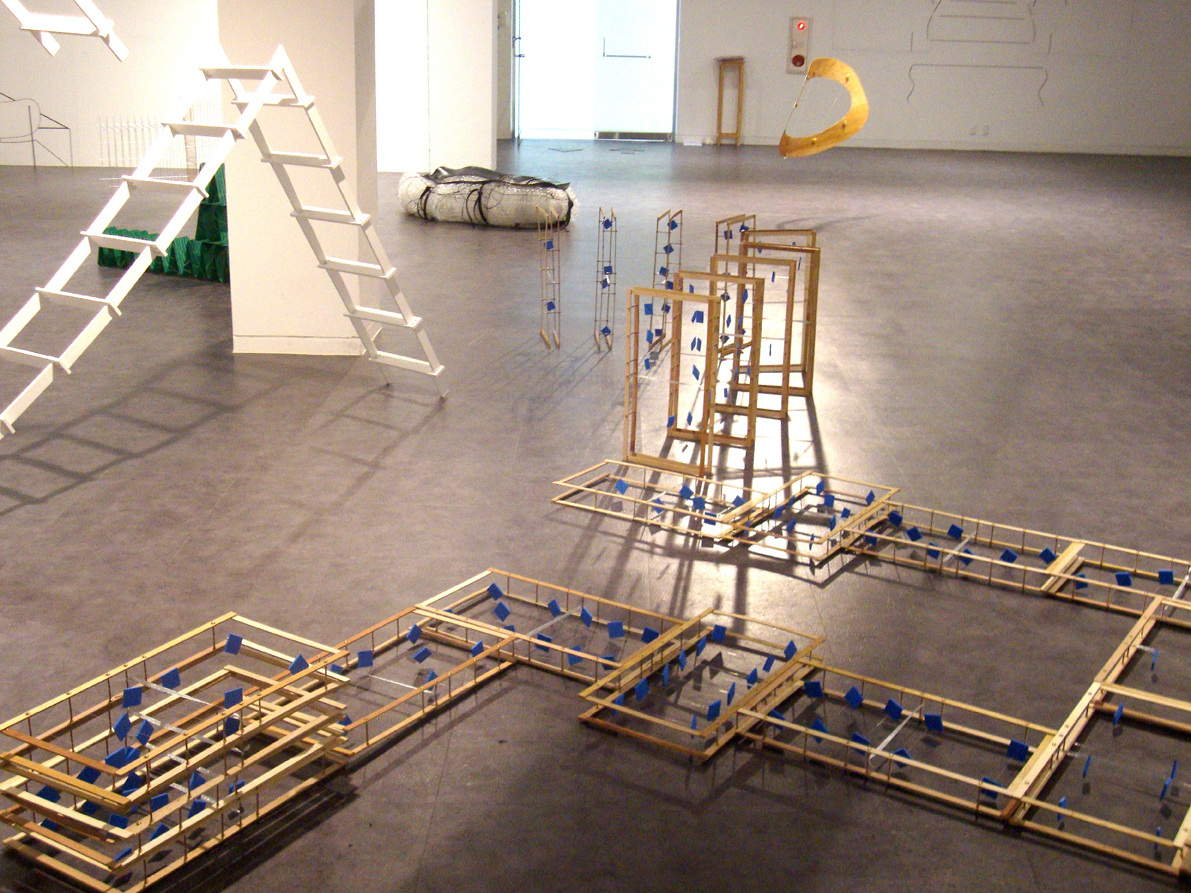(성공)
PJ Bruyniks stayed as a resident at the Gyeonggi Creation Center (GCC) from October to December 2014. Fascinated by how values are assigned to monuments, objects and human behavior, he translates this into constructions that emphasize a fragile yet rough appearance. He graduated from the Rietveld Academy in 2013 and this is his first residency.

After a 3-hour journey from the center of Seoul (2 hours by subway and 1 hour by bus), I arrived at the GCC on Daebudo Island, which is connected to the mainland by a kind of causeway. The GCC is a huge complex of 7 buildings: 3 buildings for the more than 50 residents, a building with a wood workshop, screen printing room and printing area, a building with the canteen and an auditorium above, a building with exhibition areas and administration and another with workshops and areas for activities with children. There are also two vegetable gardens, a basketball court and a lawn with a grandstand. The Korean residents usually stay there for 1 to 2 years - some for 5 years. The 3 non-Korean residents stay for 3 months. Every year there is an open call for 3 times 3 non-Korean residents.
Korea and speed
In my luggage clothes for three different seasons (arrived at 30 degrees and left at minus 10 degrees), some drawing stuff and with the idea that I would make a work related to the Korean penchant for speed. In preparation, I had delved into what is special about and in Korea. To this rather difficult question - what would I say about the Netherlands? - a Korean in Amsterdam came up with the answer that in Korea everything happens fast. Even has to happen fast. Koreans call it that they have a 'hurry up hurry up' (ppalli ppalli) culture. A word you learn quickly because you hear it often. And speed is everywhere: fast wifi everywhere, fast walking is not a sport here but a way of locomotion, and fast food is not a greasy fryer smoke but a dozen small dishes within a few minutes. Even if you then have to prepare it yourself on the barbecue or mix some combination with the rice. And that can also be eaten quickly because for the rice they use a spoon and not chopsticks as in most other Asian countries. Chopsticks here are made of iron - perhaps too slippery for rice? Clean faster though!
First Impressions
Even though I had seen pictures of the GCC beforehand, I was still overwhelmed by its size. After walking around the complex twice looking for my contact person - described in the email as my Personal Curator - the Korean-only speaking receptionist managed to point me to the right building. After a brief tour, I then arrived at my studio: a third floor apartment that was completely empty except for a table, some chairs, a bunk bed and a few kitchen items. Now I was taken aback by the size in a different way - much smaller than I thought - mainly due to the low ceiling - and looking more like an austere, spacious hotel room. My first thoughts were: what am I doing here? The space is much smaller than my own workspace in Amsterdam and the amount of tools of the woodworking shop seemed little. Perplext as I was, I went first to stock up on some food and such.
The nearest convenience store is a 10-minute walk away in a resort. The supermarket an hour's walk away. There I was - for the first time in a residence and also for the first time for such a long time in a rural area where, except for mud flats as beaches, vineyards and persimmon trees, there is nothing urban. There was an off-season atmosphere of a vacation island with second homes and restaurants everywhere. And on the weekends, the island fills up again and people keep barbecuing - even when it snows. The large GCC complex also turned out to be quite an empty complex. Most residents were in the other buildings and worked in their studios which were former classrooms. They also ate there and not in the cafeteria. And by no means all the residents were visual artists. There were also writers, musicians and composers. Many came for only a few days a week. And then there was the language. Few spoke English and a few German or French. There was also a reluctance on their part to talk because of the lack of English. The difference in length of residency - the foreigners in groups of three for three months and the Koreans for a longer period - will also have contributed to the somewhat distant atmosphere. And myself, of course - I would have to start getting work done. And also after 2 weeks of showing something during the open studio days. The concept of an autonomous artist took on a new dimension for me. I was now truly autonomous. Out of my comfort zone of familiar materials, knowing where to get everything and where I could make things.
Speed and success
To expand on my idea - the Korean penchant for speed - I had already done some preliminary work by being in Seoul a week before the start of my residency. And I had translated the Korean word for speed back and forth a few times with google and then came up with a translation that the Korean word for success (성공) also means speed and going. That connection between success and speed corresponded even better with what I had come to know about Korea: the country with the most plastic surgery where even mothers urge their daughters to look "better" for a successful life, the many drill schools where children are prepared for entrance exams, the importance of fortune tellers, the quickly constructed prestigious buildings, and the tendency for everything to be as efficient as possible. Like the directional arrows for the pedestrian crossings, and on the stairs and in the corridors of the subway stations. And in those stations, even marching music is played when the subway arrives. And while you wait for the subway, you are entertained on the screens with all kinds of disaster scenarios that can take place in the subway. I would rather watch the immensely popular Korean soaps or K-pop music. Two enormously successful export products of South Korea to the rest of Asia and beyond. Just think of Gangnam Style by Psy. Gangnam, by the way, is a district of Seoul that also has the highest concentration of plastic surgery clinics. When I went somewhere for coffee it turned out to be the coffee shop of a clinic. Looking through books there it is clearly stated what is a correct (facial) line and what is not. Usually the more western lines - which actually leads to fusion faces. And now this seems to be becoming a trend again in South America where people are having plastic surgery to look more Korean. Plastic surgery for success - translated differently: shaping procedures to achieve something. Seems like making art this way.
Soon I decided to use as a basis the six forms of the Korean word for success (성공). But with what material? Instead of resident, I became material forensics. A forty-five minute walk to the local hardware store - not a hardware store because they don't exist in Korea - just family stores crammed with everything - and sometimes nothing. Or traveling three hours to Seoul (and three hours back) to go shopping in the neighborhood around the art academy. First just to see what they have and take away everything to make prototypes for the open studio days. Later with the translation app on the phone more targeted. And also quite often. I estimate that as material foragers I spent over 10 days traveling to find and bring material. I also hiked a lot in rural areas in the beginning. Turned out to be excellent for coming up with ideas and other hunches. It's like having a little book next to your bed where you cross out half of it the next morning.
Making
So after a few weeks, I ended up in a making bubble. And the rhythm of that was indicated by the 12 o'clock clock lunch. And a very good lunch. Always 4 to 6 different dishes - besides the rice, the kimchi (the national dish: fermented vegetables, mostly cabbage, in a red pepper sauce) and the soup. The workshops had become my private domain and I had become accustomed to the limited choice of tools. On the other hand, they do have a coffee roaster which is very convenient since coffee is at least 4 times more expensive than in the Netherlands. Despite that, the country is dotted with coffee shops and there are vending machines everywhere with hot cans of coffee. And there is a table tennis machine in the GCC if you want to play against yourself.
In addition to visualizing the Korean characters, I began to make other constructions. Especially when the space was determined for my exhibition: 18 by 15 meters and over 60 meters of white wall.
Over 2 months the making bubble lasted during which summer greenery transitioned to fall colors before finally turning snow white. Interrupted only by material commands and mentor visits. That's one of the good things about GCC - the artists are regularly visited by mentors. They also have a team of curators who hold regular meetings. Too bad those are only in Korean. And the same goes for almost all other activities at GCC. There is a lot going on - on some days busloads of people and especially often children come. There are seminars, performances and all kinds of workshops. The GCC is therefore a provincial government-supported organization founded from the Geyonggi Museum of Modern Art, partly with the advice of Janwillem Schrofer (then director of the Rijksakademie), whom I spoke to during my preparations.
All in all, the making bubble led to 9 constructions, 4 wall-filling line drawings with tape and a floor work. Increasingly loose based on the Korean word for success. Still, this turned out to be quite sensitive at times - both mentors and curators commented on the Korean obsession with - quick - success. But making work about this as an outsider was painful for some. As if they were ashamed of something. A side of Korea that people would rather not show, even though it is reflected in all kinds of things. And actually I did the same - worked fast and to be in such a making bubble I find my own success.




